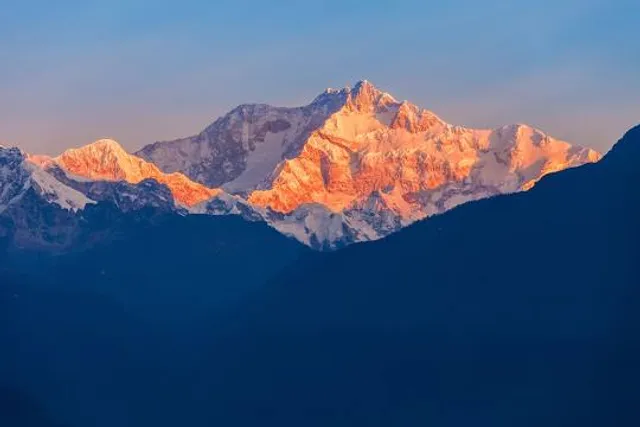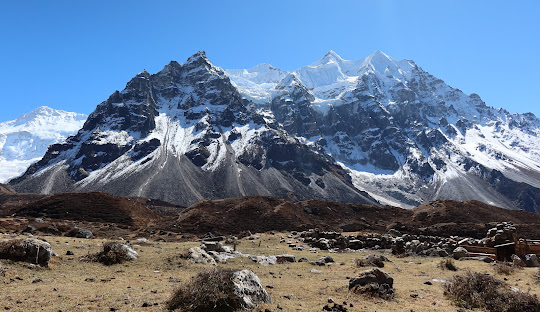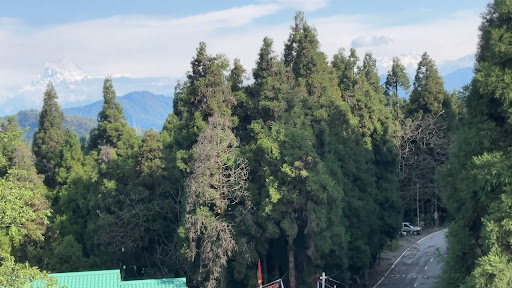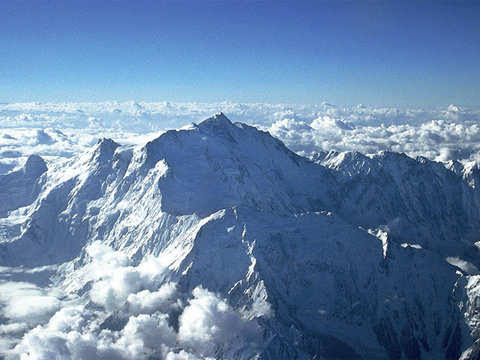Kangchenjunga, also spelled Kanchenjunga, is the third highest mountain in the world. It rises with an elevation of 8,586 m (28,169 ft) in a section of the Himalayas called Kangchenjunga Himal delimited in the west by the Tamur River, in the north by the Lhonak Chu and Jongsang La, and in the east by the Teesta River.3 It lies between Nepal and Sikkim, India, with three of the five peaks (Main, Central, and South) directly on the border,4] and the remaining two (West and Kangbachen) in Nepal's Taplejung District of Province No. 1.[5]
Until 1852, Kangchenjunga was assumed to be the highest mountain in the world, but calculations based on various readings and measurements made by the Great Trigonometrical Survey started by the British infantry officer William Lambton came to the conclusion in 1849 that Mount Everest, known as Peak XV at the time, was the highest. Allowing for further verification of all calculations, it was officially announced in 1856 that Kangchenjunga is the third highest mountain in the world.[6]
Kangchenjunga was first climbed on 25 May 1955 by Joe Brown and George Band, who were part of the 1955 British Kangchenjunga expedition. They stopped short of the summit in accordance with the promise given to the Chogyal that the top of the mountain would remain intact. Every climber or climbing group that has reached the summit has followed this tradition.
Kangchenjunga is the official spelling adopted by Douglas Freshfield, Alexander Mitchell Kellas, and the Royal Geographical Society that gives the best indication of the Tibetan pronunciation. Freshfield referred to the spelling used by the Indian Government since the late 19th century.[3] Alternative spellings include Kanchenjunga, Khangchendzonga and Kangchendzönga.[8[10]
The brothers Hermann, Adolf and Robert Schlagintweit explained the local name 'Kanchinjínga' meaning “The five treasures of the high snow” as originating from the Tibetan word "gangs" pronounced [kaŋ] meaning snow, ice; "chen" pronounced [tɕen] meaning great; "mzod" meaning treasure; "lnga" meaning five.[11]
Local Lhopo people believe that the treasures are hidden but reveal themselves to the devout when the world is in peril; the treasures comprise salt, gold, turquoise and precious stones, sacred scriptures, invincible armor or ammunition, grain, and medicine.[12]
Kangchenjunga's name in the Limbu language is Senjelungma or Seseylungma, and is believed to be an abode of the omnipotent goddess Yuma Sammang.
The main ridge of the massif runs from north-northeast to south-southwest and forms a watershed to several rivers.[16] Together with ridges running roughly from east to west they form a giant cross.[3] These ridges contain a host of peaks between 6,000 and 8,586 m (19,685 and 28,169 ft). The northern section includes Yalung Kang, Kangchenjunga Central and South, Kangbachen, Kirat Chuli, and Gimmigela Chuli, and runs up to the Jongsang La. The eastern ridge in Sikkim includes Siniolchu. The southern section runs along the Nepal-Sikkim border and includes Kabru I to III.[1] This ridge extends southwards to the Singalila Ridge.[21] The western ridge culminates in the Kumbhakarna, also known as Jannu.[1]
Four main glaciers radiate from the peak, pointing roughly to the northeast, southeast, northwest, and southwest. The Zemu glacier in the northeast and the Talung glacier in the southeast drain to the Teesta River; the Yalung glacier in the southwest and the Kangchen glacier in the northwest drain to the Arun and Kosi rivers.[22] The glaciers spread over the area above approximately 5,000 m (16,000 ft), and the glacialized area covers about 314 km2 (121 sq mi) in total.[23] There are 120 glaciers in the Kanchenjunga Himal, of which 17 are debris-covered. Between 1958 and 1992, more than half of 57 examined glaciers had retreated, possibly due to rising of air...
Read more Learn more insights from Wanderboat AI.
Learn more insights from Wanderboat AI.











